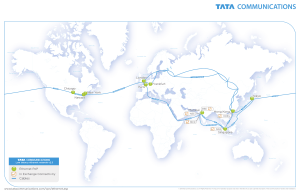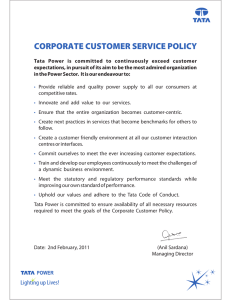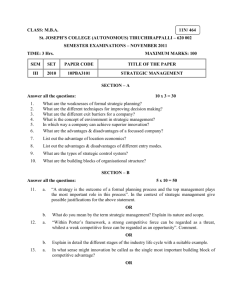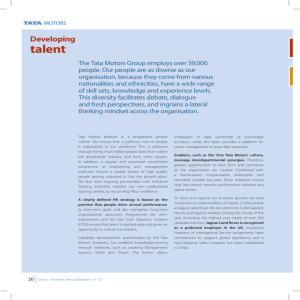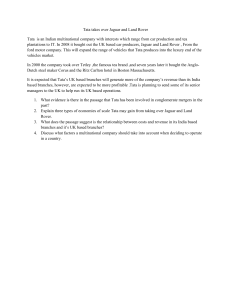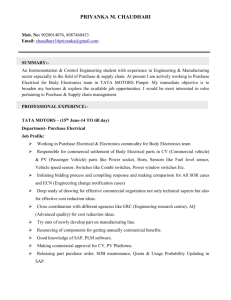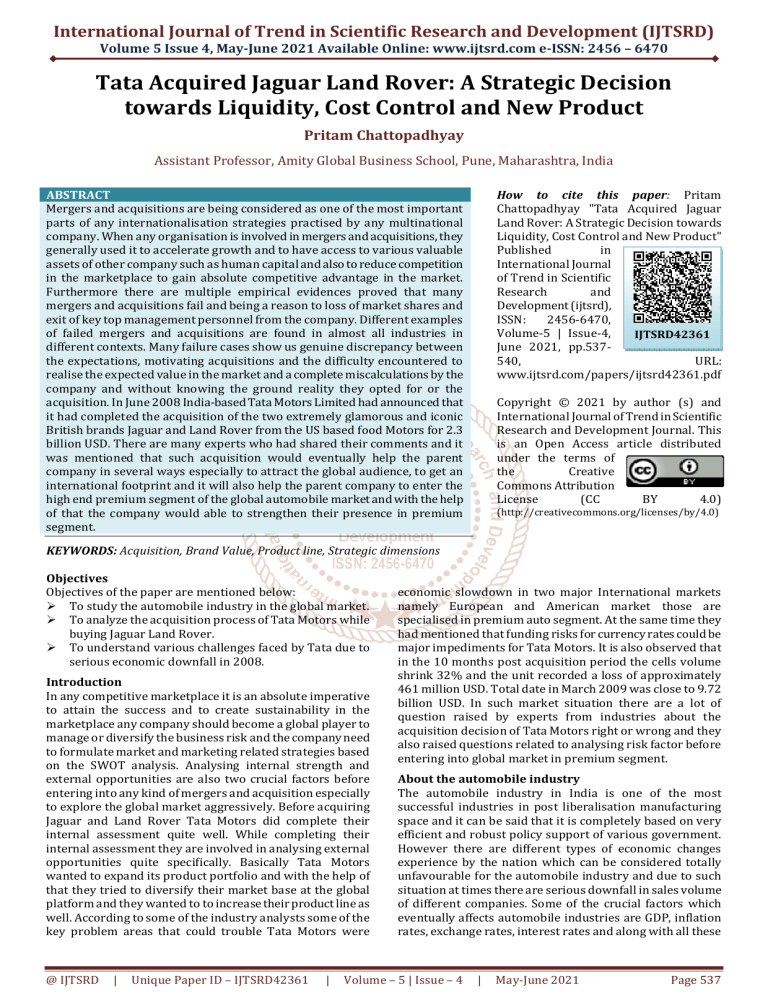
International Journal of Trend in Scientific Research and Development (IJTSRD)
Volume 5 Issue 4, May-June 2021 Available Online: www.ijtsrd.com e-ISSN: 2456 – 6470
Tata Acquired Jaguar Land Rover: A Strategic Decision
towards Liquidity, Cost Control and New Product
Pritam Chattopadhyay
Assistant Professor, Amity Global Business School, Pune, Maharashtra, India
ABSTRACT
Mergers and acquisitions are being considered as one of the most important
parts of any internationalisation strategies practised by any multinational
company. When any organisation is involved in mergers and acquisitions, they
generally used it to accelerate growth and to have access to various valuable
assets of other company such as human capital and also to reduce competition
in the marketplace to gain absolute competitive advantage in the market.
Furthermore there are multiple empirical evidences proved that many
mergers and acquisitions fail and being a reason to loss of market shares and
exit of key top management personnel from the company. Different examples
of failed mergers and acquisitions are found in almost all industries in
different contexts. Many failure cases show us genuine discrepancy between
the expectations, motivating acquisitions and the difficulty encountered to
realise the expected value in the market and a complete miscalculations by the
company and without knowing the ground reality they opted for or the
acquisition. In June 2008 India-based Tata Motors Limited had announced that
it had completed the acquisition of the two extremely glamorous and iconic
British brands Jaguar and Land Rover from the US based food Motors for 2.3
billion USD. There are many experts who had shared their comments and it
was mentioned that such acquisition would eventually help the parent
company in several ways especially to attract the global audience, to get an
international footprint and it will also help the parent company to enter the
high end premium segment of the global automobile market and with the help
of that the company would able to strengthen their presence in premium
segment.
How to cite this paper: Pritam
Chattopadhyay "Tata Acquired Jaguar
Land Rover: A Strategic Decision towards
Liquidity, Cost Control and New Product"
Published
in
International Journal
of Trend in Scientific
Research
and
Development (ijtsrd),
ISSN:
2456-6470,
Volume-5 | Issue-4,
IJTSRD42361
June 2021, pp.537540,
URL:
www.ijtsrd.com/papers/ijtsrd42361.pdf
Copyright © 2021 by author (s) and
International Journal of Trend in Scientific
Research and Development Journal. This
is an Open Access article distributed
under the terms of
the
Creative
Commons Attribution
License
(CC
BY
4.0)
(http://creativecommons.org/licenses/by/4.0)
KEYWORDS: Acquisition, Brand Value, Product line, Strategic dimensions
Objectives
Objectives of the paper are mentioned below:
To study the automobile industry in the global market.
To analyze the acquisition process of Tata Motors while
buying Jaguar Land Rover.
To understand various challenges faced by Tata due to
serious economic downfall in 2008.
Introduction
In any competitive marketplace it is an absolute imperative
to attain the success and to create sustainability in the
marketplace any company should become a global player to
manage or diversify the business risk and the company need
to formulate market and marketing related strategies based
on the SWOT analysis. Analysing internal strength and
external opportunities are also two crucial factors before
entering into any kind of mergers and acquisition especially
to explore the global market aggressively. Before acquiring
Jaguar and Land Rover Tata Motors did complete their
internal assessment quite well. While completing their
internal assessment they are involved in analysing external
opportunities quite specifically. Basically Tata Motors
wanted to expand its product portfolio and with the help of
that they tried to diversify their market base at the global
platform and they wanted to to increase their product line as
well. According to some of the industry analysts some of the
key problem areas that could trouble Tata Motors were
@ IJTSRD
|
Unique Paper ID – IJTSRD42361
|
economic slowdown in two major International markets
namely European and American market those are
specialised in premium auto segment. At the same time they
had mentioned that funding risks for currency rates could be
major impediments for Tata Motors. It is also observed that
in the 10 months post acquisition period the cells volume
shrink 32% and the unit recorded a loss of approximately
461 million USD. Total date in March 2009 was close to 9.72
billion USD. In such market situation there are a lot of
question raised by experts from industries about the
acquisition decision of Tata Motors right or wrong and they
also raised questions related to analysing risk factor before
entering into global market in premium segment.
About the automobile industry
The automobile industry in India is one of the most
successful industries in post liberalisation manufacturing
space and it can be said that it is completely based on very
efficient and robust policy support of various government.
However there are different types of economic changes
experience by the nation which can be considered totally
unfavourable for the automobile industry and due to such
situation at times there are serious downfall in sales volume
of different companies. Some of the crucial factors which
eventually affects automobile industries are GDP, inflation
rates, exchange rates, interest rates and along with all these
Volume – 5 | Issue – 4
|
May-June 2021
Page 537
International Journal of Trend in Scientific Research and Development (IJTSRD) @ www.ijtsrd.com eISSN: 2456-6470
factors recession would play its own part in such industry.
The impact of these varied factors are continuously changing
pitch ultimately affect the demand of the product in the
marketplace and consumer choice criteria also influences the
overall dynamism. In such turbulent scenario only strong
and efficient strategies will help the organisation to survive
in the market and to create a competitive position to survive.
The overall strategy of Tata Motors considering
diversification acquisition and merger could be considered
as one of the best possible examples for the survival and
growth in different economic situations. In spite of such a
successful company the company was struggling right after
the acquisition of Jaguar and Land Rover in June 2008 due to
a very important factor called global financial crisis. The
Bridge loan of 3 billion USD was actually used to fund the
acquisition of Jaguar and Land Rover was actually due on
June 2009 but yet at the end of the year 2008 Tata was only
able to repay the amount of 1 billion USD. It was quite
evident that tortoise revenue was declining and they were
experiencing a very tight credit condition which was actually
disturbing the company's cash flow and due to that they
were not in a position to take any decision as far as
marketing strategies are concerned. It is also observed that
due to the management competencies and a very positive
work ethics the company to overcome the situation and also
so every to sustain in the market place in the changing
economic situation.
Exhibit 1
Source:
https://brandequity.economictimes.indiatimes.com/n
ews/business-of-brands/jaguar-land-rover-is-headedfor-a-cash-crash/68056899
About the acquisition
After acquiring the Jaguar and Land Rover Tata Motors top
management was quite confident and pleased by looking at
its prospect in automotive industry in the world. The top
management had realised that they have created an
enormous scope for the company which will help them to
build it their competitiveness over their competitor in the
global market and at the same time they will able to keep
their identities intact as well. The brand value of Tata Motors
will move in the opposite direction with immense support
from these global players. Tata Motors aim to support their
growth by holding their basic business principles of allowing
the management and employee to bring their experience and
expertise to grow further not only in Indian market but also
in the global market as well. With the help of this business
deal Tata Motors gained many business advantages. The
acquisition would help the company to enter in the high end
@ IJTSRD
|
Unique Paper ID – IJTSRD42361
|
and premium segment of the global automobile market and
with the help of that Tata Motors would able to access a
different market segment altogether without disturbing their
basic target audience. Tata Motors also got to advance design
studios and technology as part of the deal and with the help
of that they would able to access the latest technology which
would eventually allow Tata to improve their total products
in Indian market. With the help of this acquisition they are
trying to build it a different business synergy altogether to
enhance their sustainability in the global market for the long
run. In the long-run Tata Motors will definitely diversify its
dependence on Indian market and slowly they will try to
strengthen their footprint in the global market with the help
of such large scale international brands.
While we are discussing the success story of Tata Motors at
the same time we must not forget the kind of impediments
they may face due to this acquisition at the global level.
There is a lack of access to credit to repair the bridge loan of
3 billion USD Tata Motors was facing various problems
related to cash liquidity and have negative working capital
after the acquisition of Jaguar and Land Rover. Their
problem areas don't stop here because in relation to that
their ratio had increased over five years time and they have
negative interest coverage which clearly indicates that the
company was having serious problems in the payment of
bridge loan. A bridge loan can be defined as a short term loan
which is used until a person or a company able to secure a
permanent financing or removes an existing obligation that
they already started experiencing. Such type of financing
allows the user to meet recently faced publications by
providing the immediate cash flow at different levels. The
loans are short-term in nature with relatively high interest
rates and are actually backed by some kind of collateral such
as real estate for inventory related things. Tata Motors was
actually finding it quite difficult to access the credit and raise
fund from the stock market due to the tight liquidity
conditions that they started experiencing due to this
acquisition. Depressed stock market and the lack of
investors’ confidence had also created lot of issues for Tata
Motors. Beside all these elements there is lack of working
capital which had actually caught them into trouble to repay
the bridge loan of 3 billion USD which actually used to
finance the acquisition of Jaguar and Land Rover. The bridge
loan was actually due on June 2009 and it and at the end of
2008 the company somehow was able to repay only 1 billion
USD so it is quite evident that the company is in deep trouble
in post acquisition phase.
At the same time global financial crisis had severely
impacted the international automotive industry especially
the premium or luxury car segment which had experienced a
mortgage crisis which had caused the domains of Lehman
brothers and due to that there was a huge collapse of the
global financial market and the financial crisis further
deepened due to this phenomenon. The result of this
demand of automobile also decreased at large scale in the
global market and it is observed that different premium car
manufacturers had struggled a lot to survive in the global
market due to this deepened economy. The industry also
experience that the export was declined by 38.6% during the
year 2009 due to serious meltdown in the major
International markets and due to lack of market potential.
Volume – 5 | Issue – 4
|
May-June 2021
Page 538
International Journal of Trend in Scientific Research and Development (IJTSRD) @ www.ijtsrd.com eISSN: 2456-6470
Exhibit 2
synergies out of this acquisition such as cost synergies and
revenue synergies. Tata Motors has a competitive advantage
in the Global market through the Tata Group of Companies
like Corus for Steel. The company was the main supplier of
automotive high grade Steel to Jaguar and Land Rover and
other automobile company in US and European market.
Undoubtedly Tata Group of Companies having a good
reputation in the global market and with the help of this
brand image and brand equity the company was trying its
level best to gain in and to establish cost synergies and
revenue synergies.
Source:
https://financepostsite.wordpress.com/2012/08/17/
is-the-steering-of-tata-motors-completely-in-handsof-jaguar-land-rover/
Factors affecting
Increasing material price and the fuel price had also
impacted the overall demand of vehicles and due to the
impact of very stiff monetary policy with the higher interest
rates we had seen there is a serious crisis in the raw material
price namely steel, tyre etc. Due to the rise in fuel prices Tata
Motors also experienced the slowing demand in the market.
So it was quite evident that the external business
environment was also not in favour of Tata Motors at the
time. The company had experienced a steady decrease in
sales volume and the increasing cost which was wearing the
increment of short-term date which was actually responsible
for killing the business of Tata Motors. Share price was also
dropped weight drastically and it effects the global image
and the brand image of the company as the debt market was
also frozen and due to that Tata Motors decided to turn to
the equity market to raise the fund by looking at other
available options in the market to survive for the long run
and to create a sustainable business in the global market. But
unfortunately the share price of Tata Motors was also went
down quite significantly due to quiet obvious and certainty
of the acquisition success and the global crisis which result
even in the decrease in net profit and earning per share of
the company. Looking at the picture it is quite clear that
since acquisition it was not at all a smooth journey for Tata
Motors.
Exhibit 3
Source: https://rmoneyindia.com/research-blogtraders/cyrus-and-crisis-are-they-synonyms-for-tatamotors-ltd/
It is quite clear for everybody that Tata Motors was facing a
lot of issues after the acquisition but despite of all these
difficulties the company is trying to generate two different
@ IJTSRD
|
Unique Paper ID – IJTSRD42361
|
Market related issues
It is also observed that during the year 2018-19 the demand
of vehicle decreased due to multiple reasons which already
in explained in the research paper like global financial crisis
exchange rate issues increase in crude oil price and a serious
decline of demand in the domestic market. Consequently the
Indian automotive industry had also experienced a serious
decline in both categories namely passenger vehicles and in
the commercial vehicle segment by almost 4.7 % and 22.4 %
in the financial year 2014. To diversify its marketplace and
by looking at the decrease in domestic sales of automobile
due to recession and economic downturn the company tried
to enter in China and encash the opportunity by changing its
overall corporate strategy to enjoy a significant market share
in the global market. Tata Motors try to grow in places like
China, United Kingdom and European market etc.
Exhibit 4
Source:
https://auto.economictimes.indiatimes.com/news/in
dustry/the-wheels-have-come-off-at-jaguar-landrover-for-tata-motors/67914007
Conclusion
Tata Motors decision of the acquisition can be criticized on
the ground of time of dealing that is changing the economic
situation in the global market and a serious downfall of
global economy. Post acquisition due to slowdown in the
domestic and world market the demand of commercial as
well as the passenger vehicle was also decreased and Tata
Motors was the victim of that. One of the major revenue
streams for Tata Motor was commercial vehicle before this
fascinating acquisition and the top management thought
process towards this acquisition was to develop its brand
value and equity separately in the luxury or premium car
segment in the global market but it went in vain. The overall
opportunity came to Tata Motors for the acquisition was also
the part of economic downtrend and the top management
fail to understand the consequences of the decision. What
are the strong areas for Tata Motors was their managerial
competencies along with their experience in a large market
like India and their goodwill. A great brand value and
Volume – 5 | Issue – 4
|
May-June 2021
Page 539
International Journal of Trend in Scientific Research and Development (IJTSRD) @ www.ijtsrd.com eISSN: 2456-6470
financial base actually help them to take such important
strategic decisions to go ahead in the global market despite
of a serious fall in domestic market demand. Now Tata
Motors is trying to develop its brand value and equity in the
global market with the help of some other acquisition
strategies to grow further and they try to make sure that
there should not be any further issues in financial front.
References
[1] https://www.forbes.com/sites/greatspeculations/20
16/09/27/tatas-jaguar-land-rover-continues-toaccelerate-sales-by-more-than-its-competitors-in2016/
[2]
https://brandequity.economictimes.indiatimes.com/
news/business-of-brands/jaguar-land-rover-isheaded-for-a-cash-crash/68056899
[3]
https://www.livemint.com/Money/eZLsSBnsdI5I7itG
960LdM/As-JLRs-challenges-mount-is-there-hopefor-Tata-Motors-inv.html
@ IJTSRD
|
Unique Paper ID – IJTSRD42361
|
[4]
https://rmoneyindia.com/research-blogtraders/cyrus-and-crisis-are-they-synonyms-for-tatamotors-ltd/
[5]
https://www.livemint.com/market/mark-tomarket/sales-recover-at-tata-motors-but-scepticismruns-deep-for-investors-11599828925068.html
[6]
https://www.just-auto.com/companies/tatamotors_cid189
[7]
https://www.livemint.com/Opinion/QDRd8CfgBHqOj
HD040okvI/Jaguar-Land-Rover-needs-more-than-aluxury-brand-halo.html
[8]
https://www.livemint.com/market/mark-tomarket/focus-shifts-to-tata-motor-s-acquisitionstrategy-as-jlr-loses-its-pace-1551031123941.html
Volume – 5 | Issue – 4
|
May-June 2021
Page 540

